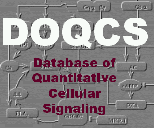| |
Reaction
Name | Pathway Name /
Pathway No. | Kf | Kb | Kd | tau | Reagents |
| 1 | PKC-act-by-Ca | PKC
Pathway No. 161 | 0.6
(uM^-1 s^-1) | 0.5
(s^-1) | Kd(bf) = 0.8333(uM) | - | Substrate:
PKC-cytosolic
Ca
Products:
PKC-Ca
|
| This Kd is a straightforward result from the Schaechter and Benowitz 1993 J Neurosci 13(10):4361 curves. The time-course is based on the known rapid activation of PKC and also the fact that Ca association with proteins is typically quite fast. My guess is that this tau of 2 sec is quite conservative and the actualy rate may be much faster. The parameter is quite insensitive for most stimuli. | | 2 | PKC-act-by-DAG | PKC
Pathway No. 161 | 0.008
(uM^-1 s^-1) | 8.6348
(s^-1) | Kd(bf) = 1079.377(uM) | - | Substrate:
DAG
PKC-Ca
Products:
PKC-Ca-DAG
|
| Ca.PKC interaction with DAG is modeled by this reaction. Kf based on Shinomura et al PNAS 88 5149-5153 1991 and Schaechter and Benowitz 1993 J Neurosci 13(10):4361 and uses the constraining procedure referred to in the general notes for PKC. | | 3 | PKC-Ca-to-memb | PKC
Pathway No. 161 | 1.2705
(s^-1) | 3.5026
(s^-1) | Keq = 2.7569(uM) | 0.21sec | Substrate:
PKC-Ca
Products:
PKC-Ca-memb*
|
| Membrane translocation is a standard step in PKC activation. It also turns out to be necessary to replicate the curves from Schaechter and Benowitz 1993 J Neurosci 13(10):4361 and Shonomura et al 1991 PNAS 88:5149-5153. These rates are constrained by matching the curves in the above papers and by fixing a rather fast (sub-second) tau for PKC activation. | | 4 | PKC-DAG-to-memb | PKC
Pathway No. 161 | 1
(s^-1) | 0.1
(s^-1) | Keq = 0.1(uM) | 0.909sec | Substrate:
PKC-Ca-DAG
Products:
PKC-DAG-memb*
|
| membrane translocation step for Ca.DAG.PKC complex. Rates constrained from Shinomura et al 1991 PNAS 88:5149-5153 and Schaechter and Benowitz 1993 J Neurosci 13(10):4361 as derived in the references cited in PKC general notes. | | 5 | PKC-act-by-Ca-AA | PKC
Pathway No. 161 | 0.0012
(uM^-1 s^-1) | 0.1
(s^-1) | Kd(bf) = 83.3333(uM) | - | Substrate:
PKC-Ca
AA
Products:
PKC-Ca-AA*
|
| Ca-dependent AA activation of PKC. Note that this step combines the AA activation and also the membrane translocation. From Schaechter and Benowitz 1993 J Neurosci 13(10):4361 | | 6 | PKC-act-by-DAG-A
A | PKC
Pathway No. 161 | 2
(s^-1) | 0.2
(s^-1) | Keq = 0.1(uM) | 0.455sec | Substrate:
PKC-DAG-AA
Products:
PKC-DAG-AA*
|
| Membrane translocation step for PKC-DAG-AA complex. Rates from matching concentration-effect data in our two main references: Schaechter and Benowitz 1993 J Neurosci 13(10):4361 and Shinomura et al 1988 PNAS 88: 5149-5153 | | 7 | PKC-basal-act | PKC
Pathway No. 161 | 1
(s^-1) | 50
(s^-1) | Keq = 50(uM) | 0.02sec | Substrate:
PKC-cytosolic
Products:
PKC-basal*
|
| Basal activity of PKC is quite high, about 10% of max. See Schaechter and Benowitz 1993 J Neurosci 13(10):4361 and Shinomura et al 1991 PNAS 88:5149-5153. This is partly due to basal levels of DAG, AA and Ca, but even when these are taken into account (see the derivations as per the PKC general notes) there is a small basal activity still to be accounted for. This reaction handles it by giving a 2% activity at baseline. | | 8 | PKC-act-by-AA | PKC
Pathway No. 161 | 0.0001
(uM^-1 s^-1) | 0.1
(s^-1) | Kd(bf) = 833.3333(uM) | - | Substrate:
AA
PKC-cytosolic
Products:
PKC-AA*
|
| AA stimulates PKC activity even at rather low Ca. Schaechter and Benowitz 1993 J Neurosci 13(10):4361 Note that this one reaction combines the initial interaction and also membrane translocation. | | 9 | PKC-n-DAG | PKC
Pathway No. 161 | 0.0006
(uM^-1 s^-1) | 0.1
(s^-1) | Kd(bf) = 166.6667(uM) | - | Substrate:
PKC-cytosolic
DAG
Products:
PKC-DAG
|
| Binding of PKC to DAG, non-Ca dependent. Kf based on Shinomura et al PNAS 88 5149-5153 1991 Tau estimated as fast and here it is about the same time-course as the formation of DAG so it will not be rate-limiting. | | 10 | PKC-n-DAG-AA | PKC
Pathway No. 161 | 0.018
(uM^-1 s^-1) | 2
(s^-1) | Kd(bf) = 111.1111(uM) | - | Substrate:
PKC-DAG
AA
Products:
PKC-DAG-AA
|
| This is one of the more interesting steps. Mechanistically it does not seem necessary at first glance. Turns out that one needs this step to quantitatively match the curves in Schaechter and Benowitz 1993 J Neurosci 13(10):4361 and Shinomura et al 1991 PNAS 88:5149-5153. There is a synergy between DAG and AA activation even at low Ca levels, which is most simply represented by this reaction. Tau is assumed to be fast. Kd comes from matching the experimental curves. |
